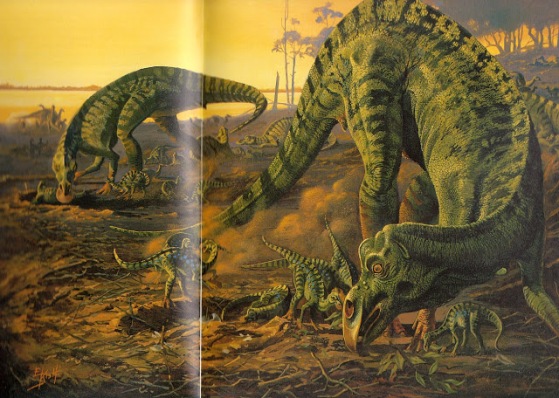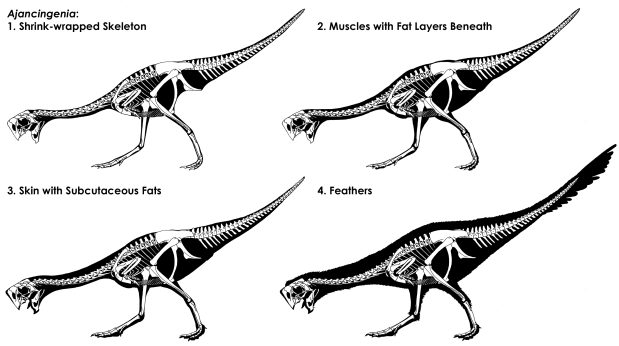What happens when you shrink-wrap a dinosaur? Well, first, you get something like the famous Ely Kish hadrosaurs:

Ely Kish’s Maiasaura peeblesorum, from Dale Russell’s Odyssey in Time: The Dinosaurs of North America, and reproduced here from a scan from Love in the Time of Chasmosaurs.
But of late, some degree of scientific accuracy has forced paleontological reconstruction to get a little more … realistic. We now tend to use living animals as more comparable biological comparisons than merely making base assumptions of anatomy, slapping skin on it, then calling it good. John Sibbick’s work, well featured in David Norman’s Illustrated Encyclopedia of Dinosaurs — which also featured a lovely rendition of the ol’ “twig and berried” Tsintaosaurus spinorhinus — demonstrates the lengths we go to to speculate, find realism, and still fall short. We’re still not there, even with the incredible and wonderfully bird-centric art of Matt Martynuick and Emily Willoughby.
But for all that, we’re still at points where people make broad guesses about how and how much, and what, goes around the bones of extinct vertebrates. It’s an exercise in frustration for some, but eventually it becomes second-nature to slap all sorts of tissues on an animal and see what works on both an artistic and scientific level. And in these, the two approaches (art and science) are very similar: Both make experimental use of swapping elements onto a broader canvas, and reducing things to what works best. Science does this by taking a chaotic whole and then reducing it by what doesn’t work, until it can find a coherent whole; art tends to be additive, than reductive, but goes through similar processes in the concepting stage, trying various poses to produce a more pleasing element, but it does this by plugging a lot of different things through the filter of human interpretation, until only a few — or just one — remain.
This can be shown in the illustration below, reduced from my Ajancingenia integument illustration:

Skeletal reconstruction (speculative, of course) of Ajancingenia yanshini — formerly “Ingenia” yanshini — given various levels of integument or reconstruction style.
Most skeletal reconstructions that have been published in the last two decades — pioneered by Charles Knight but largely ignored until Bob Bakker employed the method in the 80s, then taken up by Greg Paul, who popularized the practice — attempt to depict the skeleton as white bones on a silhouette of black showing the margins of the body. For some animals, the black outline is extreme, and one might speculate this decreases with mass: Smaller animals would have much larger proportions of muscle, fat, and integument relative to their skeletons; but giants, such as elephants, would have less. They need less, as with greater size comes greater metabolic and muscular efficiency; in addition, surface area to mass decreases with increasing size. These rules of nature, as it were, help us determine how much in probability an animal must weigh and, by extension, what its typical volume and mass must have been, or at least a reasonable constraint on it.
In Ajancinegia yanshini, above, the shrink-wrapped model (1) is the merest amount of tissue you can wrap the body in and still pretend you have a functional muscle system for the legs. There aren’t even toe pads, a crest, or a beak. But adding a reasonable level of muscle to the body (2) can alter this in some distinct ways; especially, the region between pubis and ischium are commonly treated in dinosaur art as being void of any real tissues, and the region is sunk in towards the spine, but I’ve taken the liberty of assuming pelvic muscles attaching to the ischium might just attach along the body venter and be continuous with the stomach muscles, a depiction in keeping with ornithischians and birds, animals with opisthopubic pelvises, on in which the ischium is the only bone that forms the posterior margin of the inguinal cavity of the body, supporting the intestines and caecum. Neither mammals nor birds have spines that are just poking through their skin, barely a muscle to them. Indeed, most birds have vertebrae so deeply embedded in muscle that you couldn’t see them for the muscles that surround them. So right there, a lot of the bones in an animals body are hidden, and this is also due to the fats that lie beneath the skin, between layers in the skin, or between groups of muscles, which inflate the body to some degree (3). But the biggest change comes with extra-integumental structures, things such as rhamphotheca, claws, head crests when not attached to rhamphotheca (unlikely; I imply that oviraptorids had rhamphothecal plates continuous with their premaxilla and any head crests present), and things such as fur and feathers (4). Even considering the underlying body outline, this last layer is exceptionally thick and highly variable. But it is also one of the more controversial ones, so for the most part most artists do not depict their silhouettes including this layer.
It is often enough to stop at 3 (or, in the case of Paul, 2) and most people wouldn’t look askance. Of course, I look askance and this simplicity and produce two sets of silhouettes: The basic outline expanded to level 3 and including beaks and claws, and then another one depicting 4, a process I discussed here. The second of these silhouettes go to PhyloPic, And they require a lot more speculation involved than the more or less “pure” science of figuring out how much muscle and where to put it tends to take reconstruction efforts.
So if I were to demonstrate a skeletal reconstruction for Ajancingenia yanshini with some hypothesis for its skeletal accuracy and completeness, I would show off 3 above; 2 is pretty close, but never would I show 1 as a reasonable depiction of the animal’s silhouette. 2 can be approximated as a “lean” animal, or very starving one, while 3 is a de-feathered but living animal. These are reasonable, and they don’t involve this heretical idea that these bird-like animals were feathered in any way — despite the heavy weight of data that indicates they were. But 4? That’s pushing it. Not because the idea might be wrong, but because the idea detracts from the beauty of the skeleton wrapped in its own body, with the smooth curves of muscle providing an art in itself. It is, rather, comparable to humans’ love for viewing the human body, muscle tones and curves and angles alike; applying this anthropic principle across the phylogenetic way onto dinosaurs is simple, elegant, and even explains how you get to the shrink-wrap models: A desire to see the bones, wrapped in its muscle, lean as a swimmer’s body and as lithe.
Thus, going only skin deep is rather elegant a method of demonstrating a clinical love of dinosaur anatomy. Extra-integumental structures are important, but that all comes after the body form and its properties can be addressed.



I personally prefer #4 for PhyloPic, but I’ll take any.
Oh wait, by “the second of these” you meant “the second of #3 and #4”, i.e., #4. Carry on.
Yeah, you only get the “it looks like a shadow on the wall” illustration. Never been different!
I find Numbers 2 and 3 to also be the most helpful as reference material for when I do my own life restorations of the animals. Firstly, it’s enormously helpful to have these reconstructions available at all, So thank you and others VERY much! The two dimensional and binary (only black and white) simplicity that the skeletals have not only serve to be descriptive source material for further artwork, poses, and contemplation on anatomy, but also have a unique beauty unto themselves! I also like the direction your headed with the fluffy look in number 4!
I try to give a “life” silhouette when possible. A lot of my work extends the premise that what I do must take into account a reductive, than additive, process of presenting the skeleton. The animal is positioned, then the skeleton is fit to the position, then the position is adjusted when the skeleton won’t permit the position to work in QUITE that way, and so on.
I am glad, and I know that Scott Hartman whose work also reflects this process, is glad that you enjoy our skeletal reconstructions and their general accessibility. My series of posts discussing the reconstruction efforts, just as Scott’s blog does, aims to allow people to form scientific hypotheses on their own, and better inform them on their own decisions. Neither of us preach that only one way exists. that said, the appreciation of this style of skeletal reconstruction is an emergent phenomenon: It is found to be pleasing and appropriated as ideal. You can thank Charles Knight for that.
Jaime, may I point you to a very good source on how much soft tissue goes onto a skeleton: Allen et a. 2009.
Allen, V.R., Paxton, H., and Hutchinson, J.R. 2009. Variation of center of mass estimates for extant sauropsids and its importance for reconstructing inertial properties of extinct archosaurs. Anatomical Record, 292:1442–1461.
I think this actually pertains to my comment in that it is the source of my use of that comment, but I’d forgotten the reference! So thank you for pointing it out. And in case it seems I am making that up, thank you for providing a reference to more clearly discuss the issue of using theoretical mass to control volume in models.
Jaime, I know how easily people forget that ref; I’ve been shoving it at people like crazy – but it seems Viv’s name simply doesn’t pop up in people’s mind when they think of fat animals!
Pingback: Understanding the Fossil Record Bias, Part I: Fossilization's Influencing Factors - Rex Machina